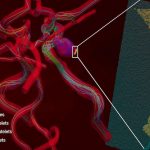 Leopold Grinberg of Brown University and an international team of researchers have used three of the world’s fastest supercomputers to create a detailed and sophisticated model of clot formation in an aneurism — a bulging of a vessel wall as it fills with blood. Grinberg’s team used magnetic resonance imaging (MRI) data taken from a patient with an aneurism to create a realistic model of the major arteries in the patient’s neck and brain and more than 300,000 computer processors to simulate a rupture of the aneurism, blood flow through the system, and formation of a clot.
Leopold Grinberg of Brown University and an international team of researchers have used three of the world’s fastest supercomputers to create a detailed and sophisticated model of clot formation in an aneurism — a bulging of a vessel wall as it fills with blood. Grinberg’s team used magnetic resonance imaging (MRI) data taken from a patient with an aneurism to create a realistic model of the major arteries in the patient’s neck and brain and more than 300,000 computer processors to simulate a rupture of the aneurism, blood flow through the system, and formation of a clot.
Creating accurate, real-time computer simulations of how blood clots work—and the role they play in medical emergencies—could, in the future, dramatically improve the way that doctors predict the risk of damaging clots and treat the damage incurred by strokes and heart attacks. [Slideshow]